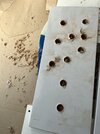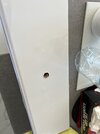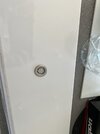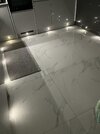I was installing some plinth lights in the kitchen over the weekend and it went reasonably well, except for some holes that were misbehaving. Let me explain…
I was using a Bosch spade bit (with screw tip) and the light had a flange which meant that some of the imperfections of the hole can be covered. The plinth had an acrylic type finish. One of those gloss kitchens.
I practiced lots of holes on a spare piece of plinth and found that whether I have the drill inserting the surface at full speed or very low speed, it didn’t make a difference. I got a reasonably clean hole. I decided to go with the slow speed insert into the plinth.
When I did it for real, approximately 3 of the 20 holes ripped the surface beyond what will be covered by the flange of the light. In the end I used a bit of glue to stick it back to the surface and since it is so low down, it’s hard to notice. Unfortunately, I don’t have a picture of the damage.
I am hoping this makes sense and there may be an explanation as to why everything worked fine in my test (pic attached) and for most of the holes apart from a few. There was no discernible difference.
I’ve added a bunch of pictures.
I welcome your thoughts on this.
I was using a Bosch spade bit (with screw tip) and the light had a flange which meant that some of the imperfections of the hole can be covered. The plinth had an acrylic type finish. One of those gloss kitchens.
I practiced lots of holes on a spare piece of plinth and found that whether I have the drill inserting the surface at full speed or very low speed, it didn’t make a difference. I got a reasonably clean hole. I decided to go with the slow speed insert into the plinth.
When I did it for real, approximately 3 of the 20 holes ripped the surface beyond what will be covered by the flange of the light. In the end I used a bit of glue to stick it back to the surface and since it is so low down, it’s hard to notice. Unfortunately, I don’t have a picture of the damage.
I am hoping this makes sense and there may be an explanation as to why everything worked fine in my test (pic attached) and for most of the holes apart from a few. There was no discernible difference.
I’ve added a bunch of pictures.
I welcome your thoughts on this.
Attachments
-
 5C6C0109-7B14-4AC4-9370-35A4F86C5B9E.jpeg206.8 KB · Views: 63
5C6C0109-7B14-4AC4-9370-35A4F86C5B9E.jpeg206.8 KB · Views: 63 -
 E2BF5939-97FD-4AFC-BE5E-ED91CD1E7B6D.jpeg270.2 KB · Views: 70
E2BF5939-97FD-4AFC-BE5E-ED91CD1E7B6D.jpeg270.2 KB · Views: 70 -
 12A79936-ED79-44D2-BED0-5E77C4E1AB93.jpeg162.5 KB · Views: 55
12A79936-ED79-44D2-BED0-5E77C4E1AB93.jpeg162.5 KB · Views: 55 -
 F917CD97-65EA-4370-9A84-47F4860052A3.jpeg138.7 KB · Views: 57
F917CD97-65EA-4370-9A84-47F4860052A3.jpeg138.7 KB · Views: 57 -
 A3B31DD0-A3D2-4CE3-85AA-63BD12FD9116.jpeg59.4 KB · Views: 60
A3B31DD0-A3D2-4CE3-85AA-63BD12FD9116.jpeg59.4 KB · Views: 60


